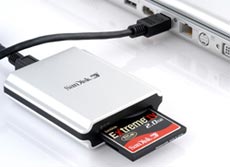9 things to note about memory cards
Some notes when buying a memory card is to choose the right type, determine the size you need, check the speed of the card. Besides, the security of data on the memory card is also important.
1. Don't buy the wrong type of card
Make sure you know the exact type of memory card for a camera, mobile phone, PDA and gaming device before you buy it. Many devices will not be compatible with a certain card so you have to check and use it to avoid accidental purchases accidentally. Check if your device accepts the card and activate some operations on it.
Currently there are about 6 main types of cards available in the market, such as SD, MMC, Memory Stick, CompactFlash, xD-Picture Card and SmartMedia. However, according to the development of technology, users can now be "disturbed" because there are many generations or versions. For example, SD has other types such as miniSD, microSD (also called TransFlash) and SD High-capacity (SDHC). While Memory Sticks have Memory Stick Pro Duo . Using the same technology, the sizes and styles of these versions vary.
2. Don't rely on the memory card that came with the device
Some of the current consumer devices come with many memory cards, however, it is usually low-capacity. For example, Sony PSP gaming devices often come with a 32 MB Memory Stick Pro Duo card, and they usually run out quickly after saving some games, songs or photos. Buy the maximum amount of "wallet" you allow because you can store more and have less to change.
3. Let your device determine the card capacity
Large capacity memory cards not only bring convenience to devices, but are also required for some devices. For example, high resolution digital cameras will consume a lot of space. If you only use 32 MB card, you can take 16 photos with 4 Megapixel camera and 10 shots with 6 "dots". So for digital cameras, the general rule is that the higher the resolution, the larger the memory card capacity.
Large card capacity allows you to store more messages, text data, music, movies and photos. An MP3 song averages 4 MB of memory and a movie equal to hundreds of times that song. Therefore, it is easy to see why a multimedia device is easily filled with memory cards.
4. Don't forget the speed

Each device supports a different type of card
The speed of a memory card is usually expressed in numbers: 10 MB / sec or 20MB / sec - writing speed per second, or through multiplier (like 60x or 80x). These symbols or terms indicate how quickly information or data can be written or read.
The faster the speed, the faster the memory card can recover data quickly after recording. This is especially important for digital images. A high-speed memory card means you can take a photo faster than usual, especially in high-resolution cameras.
However, if your device is not a "top ten" type, the speed is "fast" and you should not use fast speed cards to do anything.
5. Not all memory cards are the same
There are many different manufacturers, all of which are similar in size and features. But not every card is the same. Memory cards are produced in many standards so users can buy a cheap one and use it with many devices. However, this case is rare and mostly lucky. The advice is that you should buy cards with familiar brands and from official distribution agents.
6. Can the same card be used on different devices?
Different devices can use the same card, for example, PDAs, laptops or mobile phones can use SD cards. However, during use, you may not be able to access or use the stored data on it when transferring the card to another device because the personal device only supports special file structures. For example, a phone that does not support MP3 cannot play mp3 files on the card.
7. Is the data stored on the memory card safe?
When it comes to data safety, memory cards have a few advantages over hard drives or CDs / DVDs, such as better shock protection. Since there are not many separate parts, the possibility of card crashes or moves is less than that of a normal hard drive.
Besides, it is also less broken and scratched than CD or DVD. But also because of the small size, users often lose the card rather than losing small data on it.
8. Transfer data from memory card to PC
Some PCs and laptops have built-in card readers for you to transfer content directly to your computer. If your device does not support this feature, an independent card reader can be used instead of using a USB cable to transfer data. Mostly, this card reader supports many different memory card standards.
9. Data quality determines card capacity
The more complex or expensive your device is, the larger the memory card capacity. For example, plural cameras need more memory card capacity than low-dot cameras. Expensive PDAs with full multimedia features will need more capacity if you want to use them all.
The quality of data is the last factor determining how much you need. The general rule is that the better the quality, the more capacity it takes. For example, high-resolution photos need more memory than low-quality photos, high-quality compressed music takes up more space than MP3s of average quality.
 Causes that SD memory cards work 'sluggish'
Causes that SD memory cards work 'sluggish' Walk 'market' memory card
Walk 'market' memory card Top 10 Most Popular and Used 64GB Memory Cards
Top 10 Most Popular and Used 64GB Memory Cards 'Enchanting match' market of memory cards
'Enchanting match' market of memory cards Things to know about Samsung Galaxy Note 7 microSD memory card
Things to know about Samsung Galaxy Note 7 microSD memory card